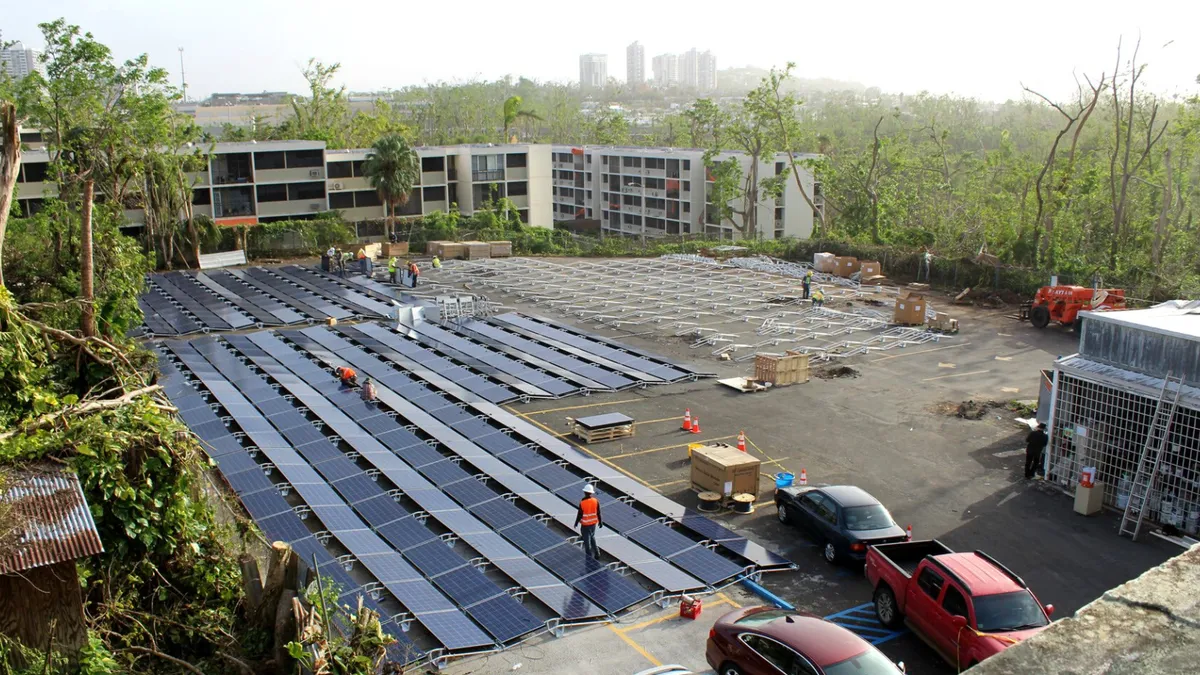Dive Brief:
- Puerto Rico can achieve 100% renewable energy by 2050 and strengthen the island’s electric grid by quickly expanding distributed energy resources such as rooftop solar and battery storage, according to a preliminary analysis from the U.S. Department of Energy.
- DOE does not have authority over how the Puerto Rico Electric Power Authority meets the requirements of the island’s renewable energy law, Act 17. However, a senior official said the department hopes to see its analysis used in the utility’s next integrated resource planning cycle in 2024.
- A final version of DOE’s PR100 study is expected in December and will examine scenarios that include Puerto Rico quadrupling the rate of DER installations to reach 7 GW by 2050.
Dive Insight:
Renewable energy potential in Puerto Rico “significantly” exceeds total energy demand now and through 2050, DOE said Friday. The island will need to upgrade both its distribution and transmission systems, in particular to accommodate the development of offshore wind resources. And officials say meeting energy demand by expanding the use of DERs can help keep the lights on during hurricanes, earthquakes and other disasters.
Preliminary results of the PR100 study found three feasible scenarios that will be further developed in the final report. One includes only economic expansion of distributed resources and for critical loads; a second prioritizes DERs for remote and low- and moderate-income customers; and a third “maximum” scenario considers adding DERs to all homes capable of supporting a system.
Across all scenarios, distributed solar capacity would range from 3 GW to 7 GW, DOE said.
DERs will be essential to Puerto Rico meeting Act 17 goals, according to DOE. “If only utility-scale solar and land-based wind resources were deployed, Puerto Rico could not meet its renewable capacity targets given the amount of land available when agricultural land is excluded,” the preliminary report concludes.
DOE issued its analysis one day after the Puerto Rico Public-Private Partnerships Authority voted to privatize the island’s generation. The decision must be approved by Gov. Pedro Pierluisi, but it would follow a similar approach to the operation of Puerto Rico’s transmission and distribution system.
LUMA Energy in 2021 began operating Puerto Rico’s electric grid, managing the system through a public-private partnership. According to media reports, the consortium brought on to manage the island’s generation would include liquefied natural gas developer New Fortress Energy.
A senior DOE official, discussing the PR100 study with reporters, on Friday warned against building more LNG terminals or natural gas infrastructure because they could become stranded assets. “There is no space for building more natural gas assets,” they said.
Act 17 requires Puerto Rico to reach 100% renewables with interim goals of 40% by 2025, a phaseout of coal-fired generation by 2028 and 60% renewables by 2040.
“Accelerated deployment of utility-scale solar and wind energy will reduce near-term system investment and operational costs because new utility-scale solar and wind energy is less costly to build than to operate existing fossil-fueled capacity, given current and projected fuel costs,” the DOE preliminary report found.
President Joe Biden visited Puerto Rico last year and pledged to help rebuild the island’s power grid. “I’m ready to deploy and expedite more resources from the Department of Energy and other federal agencies ... to help transform the entire system,” he said.
Secretary of Energy Jennifer Granholm is expected to visit Puerto Rico next week, DOE officials said Friday.
“For far too long, Puerto Ricans have lived with an outdated and expensive electric system where needless obstacles and long delays have prevented critical improvements,” she said in a statement accompanying the PR100 preliminary analysis. “We know that access to renewable energy can help save lives.”















